|

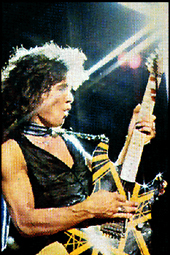  With their 1978 eponymous debut, Van Halen
simultaneously re-wrote the rules for rock guitar
and hard rock in general. Guitarist Eddie Van
Halen redefined what electric guitar could do,
developing a blindingly fast technique with a
variety of self-taught two-handed tapping, hammer-ons,
pull-offs, and effects that mimicked the sound of
machines and animals. It was wildly inventive and
over-the-top, equaled only by vocalist David Lee
Roth, who brought the role of a metal singer to
near performance art standards. Together, they
made Van Halen into the most popular American rock
& roll band of the late '70s and early '80s,
and, in the process, set the template for
hard-rock and heavy metal for the '80s. Throughout
the '80s, it was impossible not to hear Van
Halen's instrumental technique on records that
ranged from the heaviest metal to soft-pop.
With their 1978 eponymous debut, Van Halen
simultaneously re-wrote the rules for rock guitar
and hard rock in general. Guitarist Eddie Van
Halen redefined what electric guitar could do,
developing a blindingly fast technique with a
variety of self-taught two-handed tapping, hammer-ons,
pull-offs, and effects that mimicked the sound of
machines and animals. It was wildly inventive and
over-the-top, equaled only by vocalist David Lee
Roth, who brought the role of a metal singer to
near performance art standards. Together, they
made Van Halen into the most popular American rock
& roll band of the late '70s and early '80s,
and, in the process, set the template for
hard-rock and heavy metal for the '80s. Throughout
the '80s, it was impossible not to hear Van
Halen's instrumental technique on records that
ranged from the heaviest metal to soft-pop.
Through all the upheaval over lead vocalists,
Eddie Van Halen and his prodigious talent remained
at the core of Van Halen. The son of a Dutch
bandleader, Eddie and his family moved from the
Netherlands to Pasadena, California in 1967, when
he was 12 years old and his older brother Alex was
14. As their father supported the family by
playing in wedding bands, Eddie and Alex continued
their classical piano training. Soon, both boys
were enraptured by rock & roll. Eddie learned
how to play drums and Alex took up the guitar,
eventually switching instruments. The brothers
began a hard-rock band called Mammoth and began
playing around Pasadena, eventually meeting David
Lee Roth. At the time, Roth, who had been raised
in a wealthy Californian family, was singing in
Redball Jet. Impressed by the Van Halen brothers,
he joined forces with the group. Shortly
afterward, bassist Michael Anthony, who was
singing with Snake, became a member of Mammoth.
Eddie Van Halen became a role model for modern
guitarists, regardless of their tastes and
preferences. His talent and skill were
unquestioned, and he demonstrated a dazzling array
of techniques, from simple riffs to extended solos
filled with intricate fret work.
"Eruption," an instrumental track on the
first album, became his calling card as it was
transformed into a lengthy showcase during
concerts.
|
|  |
|
EVH
Gear
|
|

|
|
The
Custom built "Franken-Strat"
1978 to 1984
Edward
bought the ash body from Linn Ellsworth in 1975 for fifty
dollars and the neck (also a cast-off) for eighty dollars.
Originally, the body came with single-coil bridge, neck, and
middle pickup positions pre-routed and Van Halen, with a chisel,
excavated a hole to house a humbucker in the bridge position. He
placed in this chiseled hole a P.A.F. from a 1961 Gibson ES-335. The pickup was also
"ruined" but sounded good so it's what he used. The
single-coil neck pick-up was completely disengaged. The guitar
was first sprayed with black and then white Scwinn acrylic
lacquer bicycle paint and mounted a black strat-style pickguard
(also home-made) eventually only covering the two front
(electronics) routings. The Guitar was eventually repainted
with red, black and white stripes and orange truck reflectors added to the back of the guitar.. This red-Frankenstrat first
appeared as the black and white guitar pictured on the debut VH
album The nut was brass and the tailpiece unit was from a 1961
Fender Stratocaster. This guitar was Edward's main instrument
for the first several albums and tours. During the band's second
world wide stampede Van Halen replaced the original tremelo with
then-prototype Floyd Rose. A quarter was attached just under the
top-back side of the floyd Rose to keep it from rising up.That
first Linn Ellsworth neck was broken by the guitarist's rigorous
stage antics and replaced with whatever was handy (including a Danelectro at one point). The Ellsworth neck
sported Gibson jumbo frets ("I put those in with the help of
some Crazy Glue"-EVH). The tuning heads were Schallers.
"There's really no secret. The reason I use what I use is
through trial and error,"-EVH
|
|
|
Kramer
Guitars
1983 to 1991
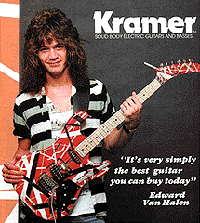 In
1983 Ed began endorsing Kramer guitars and used customized
Kramer guitars and necks. In
1983 Ed began endorsing Kramer guitars and used customized
Kramer guitars and necks.
Although a Kramer EVH signature model was never created the
Kramer "Baretta" was modeled after Ed's frankenstrat
(minus the paint job and other EVH customizations)
|
|
|
The
Stienberger
1986 to 1998
 Edward
introduced the Stienberger Tran's Trem equipped guitar into his arsenal
in 1986. Edward
introduced the Stienberger Tran's Trem equipped guitar into his arsenal
in 1986.
This transposing trem first appeared on the 5150 album and tour.
The trans-trem tremelo can be heard on the songs "Summer
Nights" and "Me Wise Magic" to name a few
|
|
|
EVH
Music Man Signature Guitars
1991 to 1994
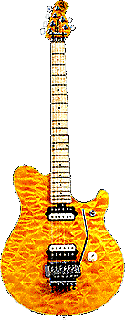 In
1991 Ed collaborated with Earnie Ball to create a EVH signature guitars of Ed's design. In
1991 Ed collaborated with Earnie Ball to create a EVH signature guitars of Ed's design.
Ed
and Earnie Ball split in 1994
due to problems with slow production and distribution.
Size:
12 5/8" wide, 1" thick, 36 5/8" long
Weight: 8 pounds. Varies Slightly
Body: Wood Basswood with bookmatched figure mapel top
Finish: High gloss polyester
Bridge: Music Man Floyd Rose licensed tremolo
Neck
Size Scale: 25" Radius: 10"
Headstock: Only
5 7/8" long
Frets: 22 - Special design unique profile fretwire
Width: 1 5/8" at nut, 2 5/32" at last fret
Wood Selected: maple neck and fingerboard, digitally
carved
to Ed's specifications
Tuners: Schaller M6La with pearl buttons
Electronics
Pickups: 2 Custom DiMarzio Humbucking
Controls: 500K volume pot with "tone" knob (the
way Ed likes it!)
Switch: 3-way toggle pickup selector
|
|
|
The
Peavey EVH Wolfgang
1995 - Present
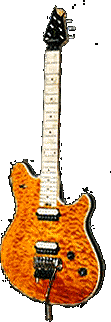 Edward
considers the Wolfgang the natural evolution of the Ernie
Ball/Music Man guitar. "It's what I would've done had I
stayed with Music Man. That would've been the next step,"
suggests Ed. "The angle of the neck is better, it's
balanced better, it's got an arched top, and it's got the
D-Tuner," he points out. Ed, in fact, owns the patent to
the unique D-tuner. (The "D-Tuna"
d-tuner allows you to drop the low E string to a D with the
flick of a switch without unclamping the trems nut lock.) Edward
considers the Wolfgang the natural evolution of the Ernie
Ball/Music Man guitar. "It's what I would've done had I
stayed with Music Man. That would've been the next step,"
suggests Ed. "The angle of the neck is better, it's
balanced better, it's got an arched top, and it's got the
D-Tuner," he points out. Ed, in fact, owns the patent to
the unique D-tuner. (The "D-Tuna"
d-tuner allows you to drop the low E string to a D with the
flick of a switch without unclamping the trems nut lock.)
Scale:
23 1/2"
Body: Basswood or figured Maple top with
basswood bottom
Neck: Bolt on oil finished figured birdseye Maple,
graphite
reinforced scuplted joint
Fret Board: Birdseye Maple
Frets: 22
Pickups: Two Humbucking designed to Edward
Van Halen's specifications.
Controls: Volume, Tone, # wat Pickup Selector
Bridge: Floyd Rose Licensed double locking tremelo with
patented D-Tuner
|
|
|
Fernandez
Sustainer
Ed uses the Fernandez Sustainer pickup
which is housed in a Custom Wolfgang guitar (not offered by
Peavey). The sustainer can be heard on the songs "Me Wise
Magic" and "A Year To The Day" to name a few.
Ed has started using a Wolfgang Special's equipped with the
Stienberger transtrem which replaces his customized Stienberger
guitar
|
|
|
Guitar
Setup
Ed's
guitars are strung with Peavey extra-light strings, gauges .009
to .042 Ed sets his action as low as possible for the easiest
playability with the least amount of resistance. His personal
setup recipe is as follows, "I lower the strings to the
point of buzz and then back it off just a hair. Why make it
hard?" Ed uses a non-floating Floyd Rose tremelo system
which preserves the bridge to guitar-body contact giving a more
stop tail piece level of sustain and tone"
I
don't know anybody that uses the damn tone control on a guitar,
at least I don't. For me, it's all the way up, period." -EVH
"I like thin frets, that way it's more precise, the bigger,
the fatter the fret is the worse the intonation is."-EVH
|
|
|
|
|
|
|
|

|

|
|
|
|
|
|
Picture
Gallery
|
|
Choose
below from the many different Eddie categories of the Picture
Gallery or browse the ClassicVH.com's Gallery or
Museum for other pictures.
|
|
|
|
|
Eddie
Links
|
|
Websites
dedicated to the greatest guitarist in rock
history.
|
|
 |
 |
|
"The
worse the press, the better." - Creem, May
1984
"I
don't even listen to the radio. I don't buy
records, I don't listen to anything. D don't
mean that I think I'm too good, that I don't have
to - but I don't get inspired by listening to
anything, except maybe Debussy." - Creem, May
1984
"Fuck
if I know how I do the things I do. I just
come up with 'em." - Hit Parader
"What's
a great song? Lots of people think songs without
singing is not a song. Tell Beethoven that and
he'll kick your ass!" - Guitar World, July
1985
"Jimmy Page is an excellent producer. Led
Zeppelin 1 and Led Zeppelin 2 are classics. As a
player. He's very good in the studio. I never saw
him play well live. He's very sloppy. He plays
like he's got a broken hand and he's two years
old. But if you put out a good album and play like
a two-year-old live. What's the purpose?" -
Guitar World, January 1981
Rethinking Jimmy Page:"He's a genius. He's a
great player, a songwriter, a producer. Put it
this way, he might not be the greatest executor of
whatever, but then you hear a Page solo, he
speaks. I've always said Clapton was my main
influence, but Page was actually more the way I
am, in a reckless-abandon kind of way." -
Guitar World, February 1990
Dave
somehow manages to come up with something for some
of my most fucked up guitar playing. I'm thinking,
nobody could do anything with this!! 1980
On
David Lee Roth following the commotion with him
after the 1997 Music Awards:
"Well,
he's an intelligent, well-read guy. But it's like
he can't connect the dots somehow." (Guitar
World, March 1998).
On how
he developed his own style:
"I was
so used to doing old blues licks with the first
three fingers. When I started using my pinky and
finding more spread things, that's when I started
getting my own style." (Guitar Classics
XI--Guitar Presents #27, 1995)
On Music
Inspiration:
"Everything
comes to me while I'm sitting on the pot."
(Guitar World, March 1998)
On
musicianship in general:
"You've
only got 12 notes and however you mix them up is
your thing." (Guitar Classics XI--Guitar
Presents #27, 1995)
|
|
 |
 |
|
|
|

|
|
Marshall
 In
Van Halen's early years Ed's now classic tone was a partly due
to his 1960's(66 or 67)Marshall Super Lead 100-watt "Plexi"
head. The Marshall ran on standard EL34's Sylvania' tubes. Ed
used a Variac to lower the voltage according to the sound he
wanted to hear In
Van Halen's early years Ed's now classic tone was a partly due
to his 1960's(66 or 67)Marshall Super Lead 100-watt "Plexi"
head. The Marshall ran on standard EL34's Sylvania' tubes. Ed
used a Variac to lower the voltage according to the sound he
wanted to hear
|
|
|
Soldano
SLO100
 When
Ed's Marshall started to fail him in the early 1990's he
switched to Soldano SLO100 When
Ed's Marshall started to fail him in the early 1990's he
switched to Soldano SLO100
|
|
|
Peavey
Ed
has settled in on his Peavey 5150 and 5150 II signature series amps. Although Ed has had his vintage Marshall restored he relies on the 120-watt 5150 series amplifiers for most studio and tour applications
|
|
|
Many
thanks to GuitarGods.com for the descriptions and pictures
of Eddie's gear.
|

|
|
 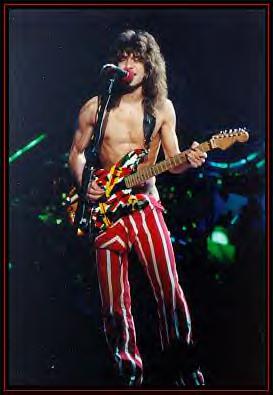
|
|
|
|
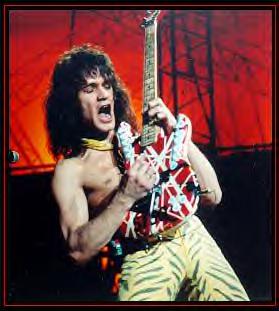
|
|
|
|
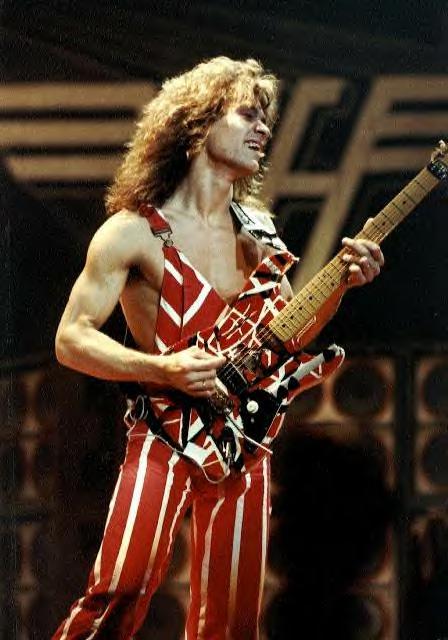
|
|
|

